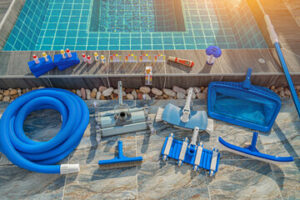Simple Pool Repairs You Can Do Yourself
Keeping your pool clean and in good repair protects the equipment, surfaces, and water from damage. Regular maintenance by Swimming Pool Services Miami also helps prevent costly repairs. Leaks, cracks, and light issues are common pool problems that require professional help. But there are some fixes you can try at home, like covering a leak with vinyl fabric.
 Getting leaks fixed as soon as they show up is essential to prevent further water loss and possible structural damage to your pool. It’s also one of the most common and costly pool repair issues. However, identifying and finding the location of a leak in a pool can be quite tricky and time-consuming. The process usually involves a dye test, and can be very expensive if the leak is in your plumbing system.
Getting leaks fixed as soon as they show up is essential to prevent further water loss and possible structural damage to your pool. It’s also one of the most common and costly pool repair issues. However, identifying and finding the location of a leak in a pool can be quite tricky and time-consuming. The process usually involves a dye test, and can be very expensive if the leak is in your plumbing system.
Plumbing leaks can occur for a variety of reasons such as poor plumbing design, installation quality, pipe material or age. The good news is that these types of leaks are often easier to repair than a structural leak.
A structural leak is a crack, tear or other form of damage that compromises the general shell designed to hold the water. These are harder to repair and can be extremely costly.
This type of leak can be caused by a variety of factors such as high slump concrete, low cement content or bad construction and curing practices. It can also be caused by soil conditions or thermal stresses.
Structural leaks can be difficult to repair due to their location and the fact that they often occur below the water line. This can make them hard to find and can even require the entire pool to be drained for inspection and repairs.
Leaks can also occur around the equipment in your pool such as the pump, filter, heater, chlorinator or lights. A common issue is when the conduit pipe separates or breaks from the niche. This can be easy to fix with a skimmer patch kit. In other cases, it is best to hire a professional to handle this kind of leak detection and repair.
There are other signs of a leak that can be more difficult to identify. For example, if your water bill goes up unexpectedly or you have greener than usual grass around the outside of your pool. These kinds of issues can indicate that extra water is escaping from your pool and that it may be a leak somewhere near the pump or underground in your plumbing system.
Cracks in swimming pools are a normal occurrence in old gunite and concrete pools. They can be very easy to repair or a bit more challenging, depending on the size and depth of the crack.
Small, cosmetic cracks can often be repaired without draining the pool by simply jumping in with a mask and a screwdriver to remove any loose material, then widening the crack a bit. Mix some pool putty in equal parts and push it into the widened crack, smoothing it out with your fingers as you go. This isn’t as hard as it sounds, and you don’t have to worry about contaminating your pool water because the putty is nontoxic and is eventually flushed out of the pool with normal water changes.
Moderate-sized cracks, like the one in this picture, usually require a little more work to repair. First the pool needs to be drained, and the crack area needs to be cleaned and prepared, including sanding it. Next, a fiberglass layer is applied to the surface. This is done by applying a gel coat, then placing a fiberglass cloth over it, and finally another gel coat. It is a fairly involved process, and it can’t be rushed, but it isn’t as difficult as draining the entire pool for crack repairs.
If the crack is large and deep enough to penetrate the shell of the pool, a more serious solution is required. This requires proper leak detection to see if the crack is leaking water and, if it is, to figure out how much water is coming out. Then, the steps to fix it with a structural staple system are very similar to the’moderate crack’ steps above – a horizontal cut is made on the crack, holes drilled on either side, and steel or carbon fiber’staples’ are inserted and epoxied in place.
It is very important to get cracks fixed as soon as they are noticed. This is because the longer they go unrepaired, the bigger they will become and the more likely they are to be leaking water. Also, if they are caused by the foundation of the pool or by structural problems in the site, the crack can get worse over time and lead to serious issues like collapse of the shell or even loss of the entire pool.
The weight of a full pool pushes against the walls and floor, weighing it down. But when a pool is empty, groundwater can still push against it from the outside and underside, creating hydrostatic pressure that could cause the pool to crack, bulge or pop (float). To prevent this, pools are equipped with a set of hydrostatic relief valves (or plugs) located on the floor of the pool. Opening these valves during draining creates a balance of pressure between the remaining water in the pool and the surrounding soil.
However, like most things in life, they can fail and a leaking hydrostatic valve can lead to water loss in the pool as well as damage to the soil around the pool. Hydrostatic valves should be checked and replaced at least every five years and they are easy to replace without draining the pool.
A qualified pool professional can do this without draining the entire pool using a technique called float-and-grind. This involves pumping a special flowable conventional grout mix through a grid of 2 inch diameter holes cored in the bottom of the pool using a concrete pump and hose. The grout mix includes a set retarder to maintain the grout flow for up to 4 hours, giving enough time to fill any voids that have developed in the soil under your pool.
Using this method, we can repair most minor structural problems such as cracked plaster surfaces and shifting soils around the perimeter of your pool. We can also repair any cracked or chipped concrete and fiberglass. It’s a good idea to have this done before it’s too late.
When a swimming pool is drained for repairs or cleaning, it’s important to work fast and get the job done as quickly as possible so that the pool can be refilled within a week. This helps prevent the pool from absorbing too much water from wet weather and helps the topcoat to seal properly. Make sure that you have all of your tools, supplies, contractors or helpers ready to go before you start pumping and be prepared to work fast.
Lights are a great safety feature for your pool and they can make it much easier to navigate the waters at night. Unfortunately, they can get a bit temperamental, and sometimes need to be replaced. Most people think that a simple pool light bulb replacement is easy enough but it’s actually one of the more difficult repairs to do on your own, especially if you’ve never done it before. If you are going to attempt to replace a light bulb yourself then you will need a few tools like a Phillips and flat head screw driver, a multimeter (these can be found at most hardware stores), and some goggles or an underwater mask.
The first thing to do is to shut off the power to the light fixture at your electrical junction box, and then to double-check that it’s off by flipping the switch at the lighting fixture itself. You will then need to remove the screw in the top of the fixture, which is usually a Philips head screw. You should then pull the fixture out of the niche in the pool wall, being careful not to damage any of the cords that are attached.
Once you have the light out of the niche, you can start to disassemble it and unscrew the old bulb. You will then need to carefully place the new bulb into the socket, being sure that it is aligned with the tab receiver on the niche and that the bezel ring is tightened around the bulb. The bezel ring is the metal part that surrounds the outside of the lens that protects it from water.
If you find that after changing the bulb it still doesn’t work, then it’s time to turn to a professional. There are many things that can cause this, including a bad lens gasket, but there are also testing devices used by qualified pool guys and electricians to figure out the problem.
It’s always best to leave electrical repair and plumbing repair to the professionals, even if you’re fairly handy and confident in your abilities. Electrical and plumbing work involving water carries the risk of electrocution for inexperienced people and can be very dangerous.
